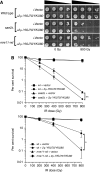Ku prevents Exo1 and Sgs1-dependent resection of DNA ends in the absence of a functional MRX complex or Sae2
- PMID: 20729809
- PMCID: PMC2957202
- DOI: 10.1038/emboj.2010.193
Ku prevents Exo1 and Sgs1-dependent resection of DNA ends in the absence of a functional MRX complex or Sae2
Abstract
In this study, we investigate the interplay between Ku, a central non-homologous end-joining component, and the Mre11-Rad50-Xrs2 (MRX) complex and Sae2, end-processing factors crucial for initiating 5'-3' resection of double-strand break (DSB) ends. We show that in the absence of end protection by Ku, the requirement for the MRX complex is bypassed and resection is executed by Exo1. In contrast, both the Exo1 and Sgs1 resection pathways contribute to DSB processing in the absence of Ku and Sae2 or when the MRX complex is intact, but functionally compromised by elimination of the Mre11 nuclease activity. The ionizing radiation sensitivity of a mutant defective for extensive resection (exo1Δ sgs1Δ) cannot be suppressed by the yku70Δ mutation, indicating that Ku suppression is specific to the initiation of resection. We provide evidence that replication-associated DSBs need to be processed by Sae2 for repair by homologous recombination unless Ku is absent. Finally, we show that the presence of Ku exacerbates DNA end-processing defects established in the sae2Δ sgs1Δ mutant, leading to its lethality.
Conflict of interest statement
The authors declare that they have no conflict of interest.
Figures







Similar articles
-
Saccharomyces cerevisiae Mre11/Rad50/Xrs2 and Ku proteins regulate association of Exo1 and Dna2 with DNA breaks.EMBO J. 2010 Oct 6;29(19):3370-80. doi: 10.1038/emboj.2010.219. Epub 2010 Sep 10. EMBO J. 2010. PMID: 20834227 Free PMC article.
-
The MRX complex plays multiple functions in resection of Yku- and Rif2-protected DNA ends.PLoS One. 2010 Nov 30;5(11):e14142. doi: 10.1371/journal.pone.0014142. PLoS One. 2010. PMID: 21152442 Free PMC article.
-
Escape of Sgs1 from Rad9 inhibition reduces the requirement for Sae2 and functional MRX in DNA end resection.EMBO Rep. 2015 Mar;16(3):351-61. doi: 10.15252/embr.201439764. Epub 2015 Jan 30. EMBO Rep. 2015. PMID: 25637499 Free PMC article.
-
Interplay between Sae2 and Rif2 in the regulation of Mre11-Rad50 activities at DNA ends.Curr Opin Genet Dev. 2021 Dec;71:72-77. doi: 10.1016/j.gde.2021.07.001. Epub 2021 Jul 24. Curr Opin Genet Dev. 2021. PMID: 34311383 Review.
-
Structure-function relationships of the Mre11 protein in the control of DNA end bridging and processing.Curr Genet. 2019 Feb;65(1):11-16. doi: 10.1007/s00294-018-0861-5. Epub 2018 Jun 19. Curr Genet. 2019. PMID: 29922906 Review.
Cited by
-
Mechanisms underlying genome instability mediated by formation of foldback inversions in Saccharomyces cerevisiae.Elife. 2020 Aug 7;9:e58223. doi: 10.7554/eLife.58223. Elife. 2020. PMID: 32762846 Free PMC article.
-
Interplay between Ku and Replication Protein A in the Restriction of Exo1-mediated DNA Break End Resection.J Biol Chem. 2015 Jul 24;290(30):18806-16. doi: 10.1074/jbc.M115.660191. Epub 2015 Jun 11. J Biol Chem. 2015. PMID: 26067273 Free PMC article.
-
Mechanism and regulation of DNA end resection in eukaryotes.Crit Rev Biochem Mol Biol. 2016 May-Jun;51(3):195-212. doi: 10.3109/10409238.2016.1172552. Epub 2016 Apr 20. Crit Rev Biochem Mol Biol. 2016. PMID: 27098756 Free PMC article. Review.
-
ATM antagonizes NHEJ proteins assembly and DNA-ends synapsis at single-ended DNA double strand breaks.Nucleic Acids Res. 2020 Sep 25;48(17):9710-9723. doi: 10.1093/nar/gkaa723. Nucleic Acids Res. 2020. PMID: 32890395 Free PMC article.
-
Modulating DNA Repair Pathways to Diversify Genomic Alterations in Saccharomyces cerevisiae.Microbiol Spectr. 2022 Apr 27;10(2):e0232621. doi: 10.1128/spectrum.02326-21. Epub 2022 Mar 30. Microbiol Spectr. 2022. PMID: 35352941 Free PMC article.
References
-
- Adamo A, Collis SJ, Adelman CA, Silva N, Horejsi Z, Ward JD, Martinez-Perez E, Boulton SJ, La Volpe A (2010) Preventing nonhomologous end joining suppresses DNA repair defects of Fanconi anemia. Mol Cell 39: 25–35 - PubMed
-
- Bae SH, Bae KH, Kim JA, Seo YS (2001) RPA governs endonuclease switching during processing of Okazaki fragments in eukaryotes. Nature 412: 456–461 - PubMed
-
- Bonetti D, Martina M, Clerici M, Lucchini G, Longhese MP (2009) Multiple pathways regulate 3′ overhang generation at S cerevisiae telomeres. Mol Cell 35: 70–81 - PubMed
Publication types
MeSH terms
Substances
Grants and funding
LinkOut - more resources
Full Text Sources
Molecular Biology Databases
Research Materials
Miscellaneous

